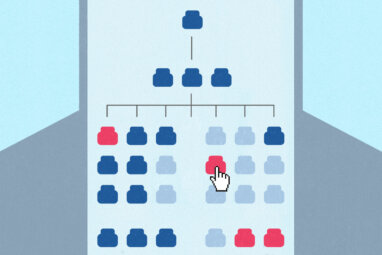1. For a summary of recent studies of project failure, see “Why Projects Fail — Facts and Figures,” accessed November 24, 2012, http://calleam.com. For examples of other explorations of research on the causes of project failure, see B.J. Sauser, R.R. Reilly and A.J. Shenhar, “Why Do Projects Fail? How Contingency Theory Can Provide New Insights — A Comparative Analysis of Mars Climate Orbiter Loss,” International Journal of Project Management 27, no. 7 (October 2009): 665-679; P.E.D. Love, D.J. Edwards and Z. Irani, “Forensic Project Management: An Exploratory Examination of the Causal Behavior of Design-Induced Rework,” IEEE Transactions on Engineering Management 55, no. 2 (May 2008): 234-247; and G. Pan, S.L. Pan and M. Newman, “Information Systems Project Post-Mortems: Insights From an Attribution Perspective,” Journal of the American Society for Information Science and Technology 58, no. 14 (December 2007): 2255-2268. Earlier references include J.K. Pinto and J.G. Covin, “Critical Factors in Project Implementation: A Comparison of Construction and R&D Projects,” Technovation 9, no. 1 (May 1989): 49-62; and J.K. Pinto and D.P. Slevin, “Critical Factors in Successful Project Implementation,” IEEE Transactions on Engineering Management EM-34, no. 1 (February 1987): 22-27.
2. K.A. Brown, R. Ettenson and N.L. Hyer, “Why Every Project Needs a Brand (and How to Create One),” MIT Sloan Management Review, 52, no. 4 (summer 2011): 61-68.
3. Project branding phases run in parallel with commonly recognized project phases: selection, initiation, planning, delivery and closure. Various authors use different terms to describe the phases in the project life cycle, but selection, initiation, planning, delivery and closure are a sensible, practical description and not inconsistent with nomenclature offered by the Project Management Institute’s Project Management Body of Knowledge. See “A Guide to the Project Management Body of Knowledge (PMBOK Guide)” (Newtown Square, Pennsylvania: Project Management Institute, Inc., 2013).
4. For a useful discussion about how to avoid the trap of focusing on time and cost while ignoring performance, see N.F. Matta and R.N. Ashkenas, “Why Good Projects Fail Anyway,” Harvard Business Review 81, no. 9 (September 2003): 109-114.
5. Some readers might raise the point that an absence of why statements does not rise to the surface in survey research on causes of project failure. One explanation is that survey findings are limited by self-serving biases. Specifically, respondents are inclined to identify causal factors they can attribute to others. A project leader may be reluctant to admit not knowing why his or her project was initiated. To avoid this bias, we have opted for a case-based observational approach to discover insights into project why statements. However, a common finding of survey research — that unclear goals lead to project failure — offers an important connection to our research. Goals can represent aspirations to close gaps and thus, if stated accurately, will connect to a project’s underlying why.
6. Brown et al., “Why Every Project,” MIT Sloan Management Review 52.
7. J.K. Pinto, “Project Management: Achieving Competitive Advantage” (Upper Saddle River, New Jersey: Prentice Hall, 2010), 10-13. In Chapter 1 (p. 12), Pinto cites a paper by V. Sohmen, “Project Termination: Why the Delay?” which was presented at the PMI Research Conference, July 2002, in Seattle, Washington, and displays a figure showing the intensity levels for client interest, client stake, resources, expenditures and uncertainty. The challenge for project branding is that just when expenditures are highest, during project execution, client (and by extension, sponsor) interest is on the wane.
8. Although it is outside the scope of this paper, we acknowledge the work of Simon Sinek, who stresses the importance of why statements as the drivers for all aspects of the work of organizations, not just projects. He argues that the lack of a mission-driven why puts an organization at risk for survival. See S. Sinek, “Start With Why: How Great Leaders Inspire Everyone to Take Action” (New York: Penguin, 2009).
9. Hammond et al. observe that failure to clearly define a problem is evidence of laziness on the part of decision makers, who stop with the obvious rather than digging deeper; the result often sets them on the wrong course of action. See J.S. Hammond, R.L. Keeney and H. Raiffa, “Smart Choices: A Practical Guide to Making Better Decisions” (Boston: Harvard Business Press, 1999). We also can view the difference between seeking the problem and jumping to solutions in what Garvin and Roberto describe as advocacy versus inquiry. Advocacy involves focusing too soon on a solution, and inquiry involves asking probing questions about the solution. See D.A. Garvin and M.A. Roberto, “What You Don’t Know About Making Decisions,” Harvard Business Review 79, no. 8 (September 2001): 108-116.
10. See, for example, H.S. Ng, F. Peña-Mora and T. Tamaki, “Dynamic Conflict Management in Large-Scale Design and Construction Projects,” Journal of Management in Engineering 23, no. 2 (April 2007): 52-66; and H.S. Desivilya and D. Eizen, “Conflict Management in Work Teams: The Role of Social Self-Efficacy and Group Identification,” International Journal of Conflict Management 16, no. 2 (2005): 183-208.
11. C.H. Kepner and B.B. Tregoe, “The New Rational Manager” (Princeton, New Jersey: Princeton Research Press, 1981).
12. J.Y. Shook, “Bringing the Toyota Production System to the United States: A Personal Perspective” in “Becoming Lean: Inside Stories of U.S. Manufacturers,” ed. J.K. Liker (Portland, Oregon: Productivity Press, 1997), 41-70.
13. See J.M. Juran, “Juran on Leadership for Quality: An Executive Handbook” (New York: Free Press, 1989).
14. D. Kahneman and A. Tversky, “Prospect Theory: An Analysis of Decision Under Risk,” Econometrica 47, no. 2 (March 1979): 263-291.
15. Pinto, “Project Management.”
i. D. Zak, “Gung-ho but Untrained, Volunteers Hit a Wall in Helping Mitigate Oil Spill,” Washington Post, June 29, 2010.
ii. See J. Flesher and N. Schwartz, “Rescuing Oiled Birds: Poignant, but Is It Futile?” June 10, 2010, Associated Press, accessed at http://usnews.com.
iii. P. Linnman, “The Exploding Whale and Other Remarkable Stories From the Evening News” (Portland, Oregon: WestWinds Press, 2003).
iv. For more on this topic, see Kahneman and Tversky, “Prospect Theory,” Econometrica 47.
v. P.G. Willis, K.A. Brown and G.E. Prussia, “Does Employee Safety Influence Customer Satisfaction? Evidence From the Electric Utility Industry,” Journal of Safety Research 43, no. 5-6 (December 2012): 389-396.
vi. For more on the traps of blaming cycles in process improvement, see N.R. Repenning and J.D. Sterman, “Capability Traps and Self-Confirming Attribution Errors in the Dynamics of Process Improvement,” Administrative Science Quarterly 47, no. 2 (June 2002): 265-295.
vii. As Bass observes, this is an example of defining a problem in terms of its symptoms, and the problem is likely to reappear with new symptoms. See B.M. Bass, “Organizational Decision Making” (Homewood, Illinois: Richard D. Irwin, Inc., 1983). It also represents an example of self-serving bias — by blaming employees, managers take themselves out of the causal equation.
viii. K.A. Brown, “Explaining Group Poor Performance: An Attributional Analysis,” Academy of Management Review 9, no. 1 (January1984): 54-63.
ix. CH2M Hill, “Project Delivery: A System and Process for Benchmark Performance” (Denver, Colorado: CH2M Hill, 1996). Beyond case-based evidence, empirical research has shown that teams whose members bring conflict to the surface early in a project tend to be more successful than those who allow conflicts to simmer. For example, see K.A. Brown, T.D. Klastorin and J.L. Valluzzi, “Project Performance and the Liability of Group Harmony,” IEEE Transactions on Engineering Management. 37, no. 2 (May 1990): 117-125.
x. This may also be viewed as a self-serving bias that gets in the way of problem definition. See D.T. Miller and M. Ross, “Self-Serving Biases in the Attribution of Causality: Fact or Fiction?” Psychological Bulletin 82, no. 2 (March 1975): 213-225.


 View Exhibit
View Exhibit


